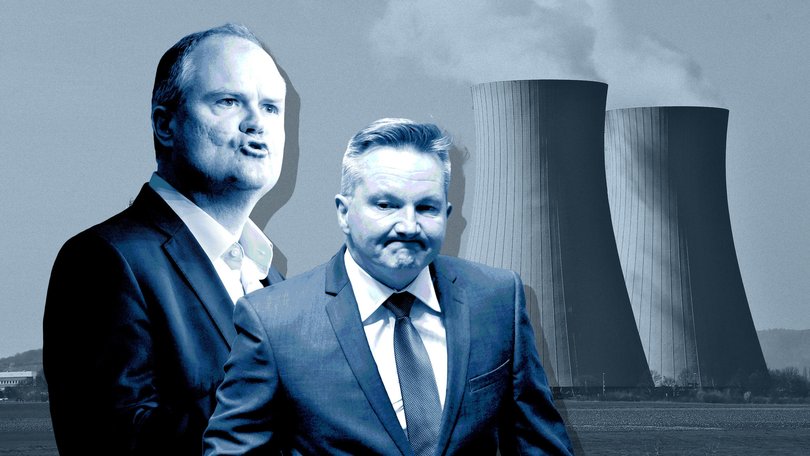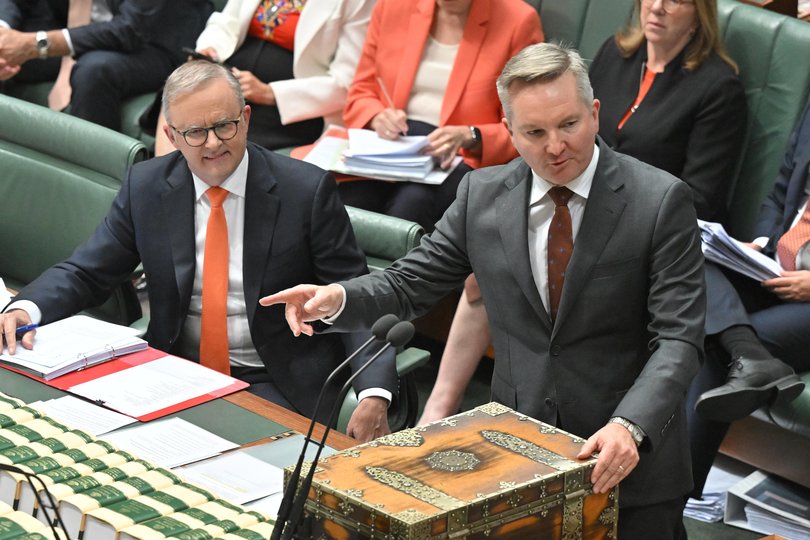Can Australia afford to introduce nuclear power to its electricity grid? Can it afford not to?

Coalition plans to introduce nuclear power to the energy mix by the mid-2030s are technically achievable, say leading international experts ahead of the Opposition’s expected announcement this week on costings.
The question is does Australia want it?
On Monday night, a fiery clash between Energy Minister Chris Bowen and his opposition shadow Ted O’Brien set the scene for one of the most ideological battles of the election.
Sign up to The Nightly's newsletters.
Get the first look at the digital newspaper, curated daily stories and breaking headlines delivered to your inbox.
By continuing you agree to our Terms and Privacy Policy.Can Australia afford to introduce nuclear power to its electricity grid? In the race towards net zero emissions by 2050, can it afford not to?
The Coalition plans to convert seven coal-fired power station sites around the country to nuclear power between 2035 and 2050. This would include two small nuclear modular reactors and five large-scale plants.
Details on the final price tag have been sparse but are expected within days, based on modelling of energy costs by Frontier Economics. This will be the second report by the advisory group and will focus on the effect of adding nuclear power to the grid.
Sources with knowledge of background discussions say Coalition advisers have been consulting with major exporters of nuclear power including South Korea, the United States and France.
The range of costings are also likely to draw from research compiled on an extensive database by the Vienna-based International Atomic Energy Agency of the finances and construction of more than 400 nuclear power plants in more than 30 countries.
The Coalition argues their energy policies will cost consumers less than Labor’s renewables-heavy strategy — a claim the Government vehemently refutes.
In the fog of politics, with both sides accusing the other of “cherry-picking” favourable economics, slicing through the impassioned arguments can be a daunting task.
On Sunday, a new GenCost report by the CSIRO added fuel to the fire by stating a nuclear power plant in Australia would likely cost twice as much as renewable energy, even accounting for increased longevity of reactors.
“It just looks to me like there’s a heavy hand of Chris Bowen in all of this,” retorted opposition leader Peter Dutton, calling the impartiality of Australia’s leading science agency into question.

“That’s deeply offensive, not to me, but to the CSIRO,” Mr Bowen hit back, defending the body’s independence.
“Basically, every expert in the world thinks that the Opposition’s plans are wildly unrealistic,” Mr Bowen told the ABC.
A basic fact-check disputes that assertion.
A House Select Committee on Nuclear Energy has, so far, held more than 25 hearings around the country at all seven sites where the Coalition proposes nuclear power. It is churning through more than 500 public submissions as it prepares an interim report by February and a final analysis in April.
A number of contributions come from international experts who have no stake in Australia’s entrenched opposition to or legislative bans at Federal state levels on nuclear energy.
“Is nuclear energy feasible in Australia? Yes,” said Andrew Whittaker, a distinguished professor of civil, structural and environmental engineering at the University of Buffalo.
“How much time is needed? Eight to 10 years, based on the experience in the United Arab Emirates — Barakah, unit 1 — and Australia has a nuclear regulator, whereas the UAE did not.”
Jacopo Buongiorno, professor of Nuclear Engineering at the Massachusetts Institute of Technology, agreed a “sophisticated, financially viable country like Australia” could follow in the UAE’s footsteps to set up an operational plant within a decade.
“Australia doesn’t start from scratch, because it has a long history of use of nuclear technology,” he said, referring to the open-pool nuclear research reactor in Lucas Heights, Sydney.
“And then, of course, the 500-pound gorilla in the room is AUKUS. So, Australia will become a nuclear country, whether Labor likes it or not,” he told The Nightly. “Why not get the benefits of this technology, also on the civilian side?”
Professor Buongiorno admits nuclear is “neither the cheapest nor the fastest energy source to deploy”, but argues that when integrated in a “balanced mix with renewables and storage” it reduces average costs of electricity to consumers because of its reliability, particularly while reducing the use of fossil fuels.
“If you look on a straight cost of megawatt hour generated by nuclear versus renewables, renewables are cheaper.. but that doesn’t tell half the story,” he said, arguing in favour of a base load of nuclear power to complement renewables.
When intermittent energy sources such as wind and solar were used to deeply decarbonise the power grid, then an enormous overcapacity of solar panels, wind turbines, electric batteries and transmission lines must be built to meet electricity demand, he said.
“A megawatt hour that is base load, that is basically always on, that is reliable … is more valuable than the mega variety you get whenever Mother Nature sends you wind and solar,” he said. “What people need to look at is the integrated cost.”
Experts also point to nuclear energy’s capacity to help meet global targets on the path to achieving net zero emissions by 2050.
“Nuclear is…the only technology that’s proven to be workable to solve this climate change problem. Renewables just can’t cut it,” said Dave Collins, managing director and principal environmental engineer of Synergetics Consulting Engineers, underlining Germany’s struggles to do so.
The Australian political debate had been “unproductive,” he said. “Engineers look at who else has done this in the world, and where are the good news stories,” he argued, pointing to South Korea as an example.
But the argument of nuclear power success abroad cuts little weight with Labor.
“Every country is different. And the issue for Australia is we’re on the cheapest path to low-cost reliable energy and electricity for Australians,” said Assistant Minister for Trade, Senator Tim Ayres, on Tuesday.
“The alternative path, the nuclear path, is expensive for Australia. It’s expensive for Australia in relative terms to some of the countries that have a comparative advantage in this area.”
A report by the Institute for Energy Economics and Financial Analysis recently found nuclear power in Australia would raise electricity bills by $665 a year on average.
IEEFA expert Johanna Bowyer, said analysis of the nuclear power in the past 20 years in North America and Europe, showed “extremely high capital costs.”
But she hit on another major hurdle to the Coalition’s nuclear energy ambitions: “We’d also need to set up the regulatory regime, which would take a really long time,” said Ms Bowyer.
It’s a question the Opposition have so far avoided. When the Coalition finally presents its costings, will it have an answer?

